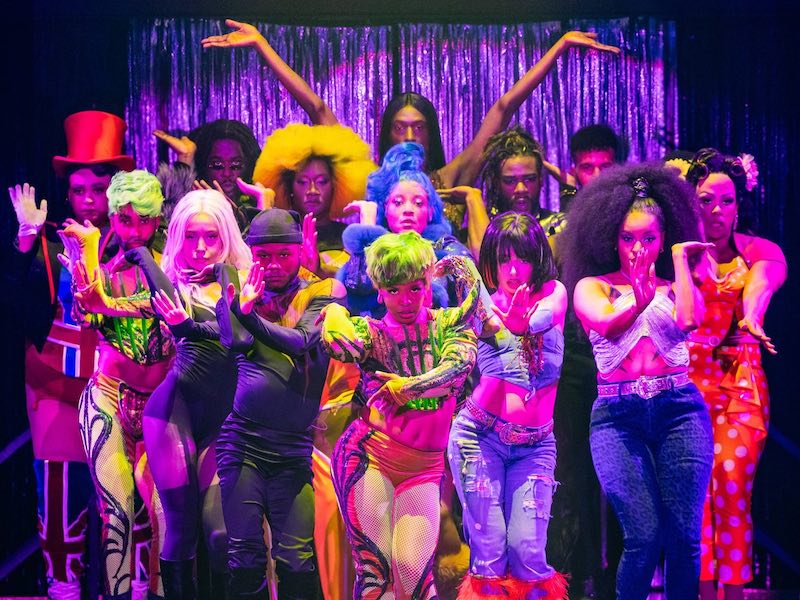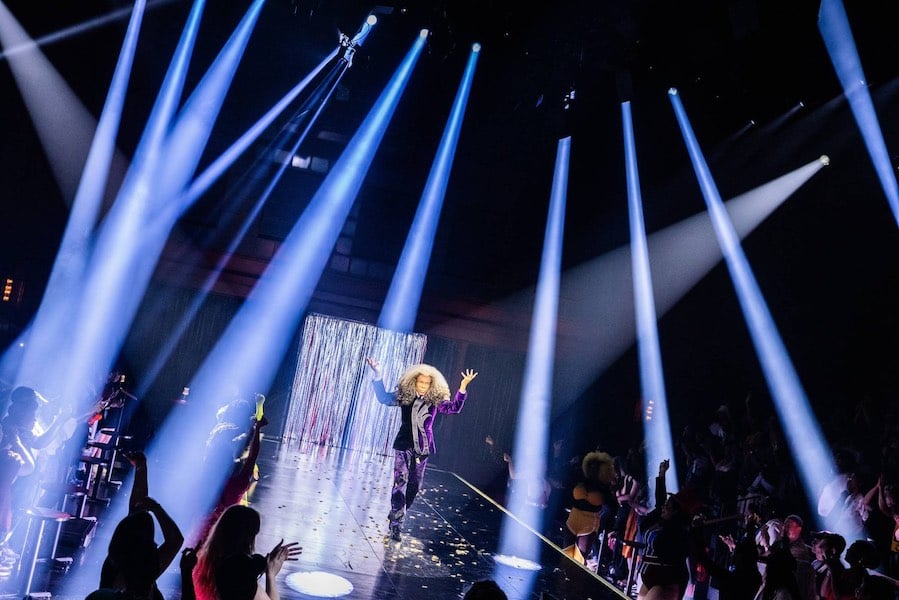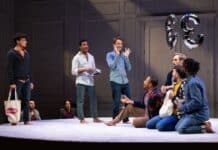I can confidently say that I have not had a more euphoric experience at a theater than I did in New York City at the Perelman Performing Arts Center’s (PAC NYC) Cats: The Jellicle Ball. This new interpretation, centered on New York City’s Ballroom culture, boasts all-new “Ballroom and club beats, runway-ready choreography, and an edgy eleganza makeover that moves the action from junkyard to catwalk.” The cats have become catwalkers, showing themselves and their fits off to an audience that has become one with the show’s Ballroom diegesis.
Cats has long been the subject of criticism that it’s two hours and 30 minutes of cats introducing themselves, but adapting the story for a format all about people introducing and celebrating themselves just puts the original Cats’ implied message at the forefront.

And don’t confuse ballroom for drag: ballroom places greater emphasis on fashion and stage presence and becomes an ideal space for highly specific, highly accessible self-expression — and cat introductions. In Qween Jean’s costume design, Mungojerrie and Rumpleteazer don tracksuits, Bustopher Jones wears a Union Jack jumpsuit, Sillabub wears overalls, Skimbleshanks wears an MTA conductor vest and tie, Misto goes full Met Gala, and Tugger leaves the shirt offstage and the audience hollering.
It’s got sparkle, mad serotonin for the Cats fans, mad serotonin for the non–Cats fans, and tremendous depth, as I’ll explain. In the hundreds of times I’ve watched or listened to performances of “Memory,” I don’t think I’ve cried like that before. Moreover, I have not been so simultaneously immersed in the world of the production onstage while being so wildly aware of, and enlightened about, the story’s real-life messaging and implications. I have never been so in love with a theatrical experience. Nor, it seemed, had the entire theater around me. On a Sunday matinee, no less. And don’t just take it from me: Andrew Lloyd Webber himself has observed this too, recently saying of a showing he attended, “I have rarely seen an audience respond with as much joy and love as I saw recently at Cats: The Jellicle Ball. The atmosphere was, quite simply, electric.”
Cats: The Jellicle Ball at PAC NYC has just been extended for a third time. This production will be remembered, beloved, and replicated for years to come. This show has reset the standard for revivals and reinterpretations.
But not all fans of Cats are happy. Earlier this summer as the now-famous clip of the new “Prologue” choreography emerged, I began seeing an opinion in parts of the Cats fan community that this production should not exist. Instead, many insisted, if someone wanted to make a show uplifting Ballroom culture then they should make a brand-new show. Adapting an old one was just confusing, and counterproductive to boot. Comments included:
“Don’t use source material that’s completely irrelevant.”
“Why take Cats and separate it SO FAR from the original source?”
“I’m all for original takes on things. Circus, 20s, underground-40s, they were all amazing. They were still… Cats.”
But that’s the thing: this production is still Cats. Absolutely, unquestionably. And that very adherence to the source material under Zhailon Levington and Bill Rauch’s direction is core to the production’s success in delivering its brand-new message. It’s like what I was taught about the Trinity: it’s more than one thing, but fully each one, with each part reinforcing the other simultaneously. This different sameness was confirmed as part of the authorial intent of Co-Choreographers Arturo Lyons and Omari Wiles in both the June 23 talkback I attended as well as a BroadwayCon panel recorded live for podcast, The Wrong Cat Died. If you listen you can hear me ask the first audience question.
Something important to mention as I get into this analysis: I am biracial but I do not identify as a person of color, and I am not queer. I am an outsider to Ballroom culture, and I viewed this production through that lens. This show is for everyone, but its thesis is a love letter to the QPOC community that also serves as something of an olive branch to cisgender, straight, and affluent white people who can pay to go to big shows in New York City.

The whole point of Cats is stated in the final song, “The Ad-dressing of Cats.” As Brian Blessed and Ken Page told us 40 years ago and as André De Shields tells us now, “You’ve learned enough to take the view/that cats are very much like you.” When Lord Andy told Hal Prince “It’s about cats,” if he meant it was not an allegory, he was on drugs.
Cats is about how the beings on stage who appear different from us have the same desires that we do. They want acceptance, they want love, they want to be themselves freely in a world that alienates them. And they will take what they are owed.
The alienators in the Trevor Nunn version are the Jellicles themselves who ostracize Grizabella; in PAC’s version, it’s the NYPD, who are this production’s kidnappers of Old Deuteronomy. In Nunn’s version, we were able to see both Macavity — who is heavily implied to be a rapist — and the Jellicles themselves as the oppressors, and see ourselves as both Grizabella and the Jellicles, craving redemption. The Nunn version, at its core, is about the importance of universal understanding and love. And so is the PAC version, which places a trans woman in the role of Grizabella.
Ultimately, these characters are human, and they demand to be treated as such.
In Trevor Nunn’s Cats, this point is ever-so tongue-in-cheek; in PAC’s Cats, it is triumphant.
This production adheres closely to the sound, script, message, and characterization of the original Trevor Nunn–directed and Cameron Mackintosh–produced West End and Broadway productions. This is the same show: this is Cats. They’re just in new costumes, and some audio elements are added during the songs that sound more Ballroom.
Even if you are an outsider to these communities being celebrated here — including the Cats fan community — you will be touched by the joy on display at any performance you go to.
This show speaks to what a reinterpretation can be: an embrace of the existing work as well as a means of showing what else it can be and mean to new people. Those who may fear reinterpretation should remember that theater is, at its core, a laboratory for artistic and cultural conversation. And to address a fear of some Cats fans who feel like those embracing the PAC show are the people who have been critical of Cats and Cats costumes, look, uh — there is no comparison between the bullying experienced by QPOC people vs… Cats the Musical fans (?). Let’s let this show we love do some good, and support it while doing so. Lord knows it hasn’t been doing that in the last few years. If you’re a doubter of this show and then attended a performance, I think you’d be a little embarrassed at thinking you wanted to quash the joy and profundity on display.
On that note, I wonder if this show might be a way to begin persuading homophobes and transphobes to reconsider their beliefs. I would bet good money it’s already pulled at the doors of some closed minds. That’s how good it is.
And if you really, really want your cat fix from this show, you can listen to the completely unchanged words of T.S. Eliot’s poetry. The Rum Tum Tugger can advocate for liberation while singing about getting stuck in a drawer. Go figure.
And I will figure. These songs about the cats’ stories — their “impracticality” — beautifully serve as allegories for the experience of being the “other,” a diminished yet powerful minority in a society not built for you. PAC’s show is just saying the quiet part of Trevor Nunn’s show out loud.
Regardless of your connection to Cats the show or lack thereof, you will be affected by this show. It might not be your “most euphoric experience at a theater,” but it very well may come close.
Running Time: Two hours and 30 minutes, including one intermission.
Cats: The Jellicle Ball plays through September 8, 2024, at Perelman Performing Arts Center, 251 Fulton Street, New York, NY. Purchas tickets ($73–$309) online. Full-time educators, first responders, and anyone under 30 eligible for $30 discounts. Full-time students are eligible for 50% off tickets. Current savings programs are listed here.
COVID Safety policy: Masks optional.
Cats: The Jellicle Ball
Choreographed by Arturo Lyons and Omari Wiles
Directed by Zhailon Levingston and Bill Rauch
Inspired by the musical by Andrew Lloyd Webber based on Old Possum’s Book of Practical Cats by T. S. Eliot




